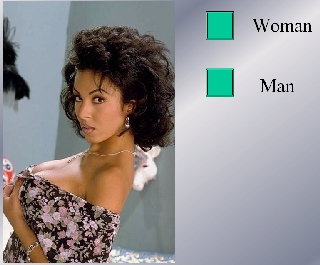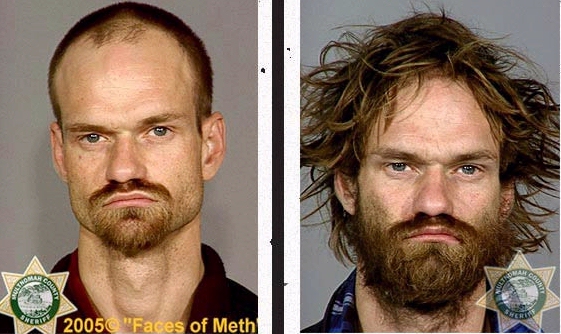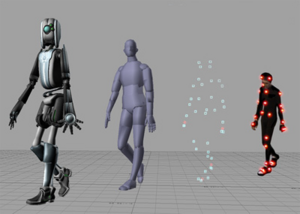
Judge Alex Kozinski posted porn online, the L.A. Times announced yesterday. But today internet bloggers discovered which porn it was!
"And now, for the more disturbing and/or pornographic images," announced conservative blogger Patterico, who claimed he'd spoken to the Times' source for two hours, and ultimately convinced him to deliver the images he'd downloaded from the judge's site. He's identified the naked women painted like cows (cropped above), the man performing fellatio on himself, and the women exposing their genitalia in front of the "Bush for President" sign. ("That is a funny joke," Kozinski admitted to the L.A. Times...)
And the "slide show striptease featuring a transsexual" appears to be just a PowerPoint quiz jokingly challenging the viewer to guess real women from the pre-op transsexuals.

Some of the photos from the PowerPoint were clearly X-rated, but the blogger posting the contents of Kozinski's directory ultimately was sympathetic. "I could be wrong, but I think that on the whole, most people will say that the actual images are slightly less offensive than one would expect from a text description," he blogged today.
And for some fans online, Kosinski is on his way to becoming their favorite judge.
At Fark, one poster remembered the time judge Kozinski contacted a supposedly female blogger at "Underneath Their Robes," nominating himself for their "Judicial Hottie" contest. ("I have it on very good authority that discerning females and gay men find graying, pudgy, middle-aged men with an accent close to Gov. Schwarzenegger's almost totally irresistible.") He proudly submitted video footage of his appearance on "The Dating Game" in 1968. (When selected, he grabs the female contestant's face and surprises her by planting a very long kiss.)
"I had my own photo-spread in George Magazine, with lots of sexy pictures of me jumping," Judge Kozinski added. "This was a few years back, but I've only gotten cuter with age."
The blog "Underneath Their Robes" was actually written by David Lat, who later became a blogger at Wonkette. "I was surprised, needless to say," Lat emailed us today about the news of the Kozinski porn stash. "But one thing I'd emphasize is that that this material was not easily accessible — you needed to know what subdirectory to enter in order to access items.
"So I'm not as scandalized as it seems other folks are. This was never material that he meant for the public to see."
And the judge himself had another explanation, which appeared today on the blog "Above the Law"
"Everyone in the family stores stuff there, and I had no idea what some of the stuff is or was — I was surprised that it was there. I assumed I must have put it there by accident, but when the story broke, [my son] Yale called and said he's pretty sure he uploaded a bunch of it. I had no idea, but that sounds right, because I sure don't remember putting some of that stuff there.
It's worth remembering that Kozinski has always been an unashamed advocate for freedom of speech — and he has a sense of humor. (When Mattel sued over the song Barbie Girl, Judge Kozinski wrote in his legal opinion that "The parties are advised to chill.") When confronted about the dirty images by the L.A. Times, he argued that at least some of the pictures were funny. Some might be offensive, he conceded, but he didn't think any matched the legal definition of obscene.
"Is it prurient? I don't know what to tell you," he told the newspaper. "I think it's odd and interesting. It's part of life."
The blogger at Patterico says the images the Times discussed had been online since December, according to his source. And one commenter at Slashdot found a cached screenshot of Kozinski's directory, with file dates as far back as 2004. But the screenshot revealed the directory held mostly the kind of viral videos one would usually find on Digg.
funny-cats-2.wmv
john.mccain.sings.wmv
monica.jpg
donkey.mpg
dont.eat.worms.mp3
Yes, some of the file names were a little racy — like fart.exe, orgasm.wav, and esheep.exe. But the Kozinski directory also held a copy of Monty Python's innocuous Lumberjack song — along with two songs by Weird Al Yankovic
Wonkette ultimately called it "the sort of naughtiness you’d find in the dirty birthday cards section at Spencer Gifts," describing Kozinski's directory as "the very worst excuse for hosting a porn stash since Mark Penn told his mom 'I'm keeping that stack of Juggs for a friend?'"
Ironically, one of the Yankovic songs in his directory gave a title beginning with the words "You Don't..." presumably the song parody "You Don't Love Me Any More." ("I guess I lost a little bit of self-esteem," Weird Al sings, "that time that you made it with the whole hockey team.") It's an odd bit of synchronicity, since the judge now faces a media firestorm — and ironically, his curiosity about free speech may ultimately make it harder for him to rule in defense of it.
Though Judge Kozinski has had a stellar career, it may be Weird Al who's ultimately provided its epitaph.
You used to think that I was nice
But now you tell all your friends
that I'm the Antichrist.
See Also:
CNN Exposes Boob Job Giveaway
The D.C. Madam Speaks
Secrets of the Perry Bible Fellowship
Sex Panic! An Interview with Debbie Nathan
Racist Porn Stars

